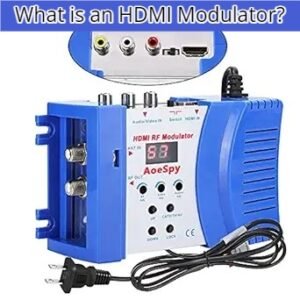
How HDMI Modulators Work: Bridging Digital and Analog Worlds
What is an HDMI Modulator?
An HDMI modulator is a device that converts an HDMI (High-Definition Multimedia Interface) signal into an RF (Radio Frequency) signal. This conversion allows the HDMI signal, typically carrying high-definition video and audio from devices like Blu-ray players, gaming consoles, or computers, to be distributed over coaxial cable networks. HDMI modulators are used in environments where legacy equipment, such as older television sets or distribution systems, require an RF input instead of HDMI.
How to Fix PDP Authentication Failure on iPhone: A Comprehensive Guide
What is an HDMI Converter Used For?
An HDMI converter, like an HDMI modulator, converts HDMI signals into another format. However, the key difference lies in the output format. HDMI converters can output signals to formats such as VGA, RCA, or even DVI, depending on the specific use case. These converters bridge the gap between modern digital devices and older analog equipment.
What is the function of a modulator on TV?
In television systems, a modulator plays a critical role by converting video and audio signals into a format suitable for transmission over different mediums, such as coaxial cables. The modulated signal can be transmitted over a single channel, making it possible to distribute the content to multiple televisions within a facility, such as a hotel or a large building complex. The modulator ensures the signals are compatible with the receiving television sets, allowing them to tune into the correct channel to display the content.
What is a Cable Modulator?
A cable modulator is a type of modulator specifically designed to work with cable television systems. It takes audio and video signals from a source device and modulates them onto a specific cable channel. This modulated signal can then be sent through the cable network to multiple TVs. Cable modulators are used in setups where centralized content distribution to various television sets is required, such as in schools, hospitals, or hotels.
What is a Modulator Used For?
Modulators are used in various applications, primarily for converting signals into a form that can be easily transmitted or processed by other equipment. In the context of television and broadcasting, modulators convert video and audio signals into RF signals, enabling them to be transmitted over long distances via cables or broadcast through antennas. Modulators are essential for transmitting data over different media types, including radio waves, fiber optics, and satellite links.
What is the Principle of Modulation?
Modulation is the process of varying a carrier signal to transmit information. The carrier signal, typically a sine wave, is modified by the input signal (such as audio or video) to encode the information. There are several types of modulation, including amplitude modulation (AM), frequency modulation (FM), and phase modulation (PM). The modulation principle allows for the efficient transmission of signals over various media, ensuring that the information can be received and decoded correctly at the destination.
What is a Cable Module?
A cable module refers to a component within a cable television system that facilitates the distribution and processing of signals. This can include devices like cable modems, tuners, or decoders that work together to manage and distribute cable signals to various endpoints, such as televisions or internet-connected devices.
What is an example of a Modulator?
A typical example of a modulator is an FM (Frequency Modulation) radio transmitter. In this case, the modulator takes the audio signal and varies the carrier wave frequency to encode the audio information. This modulated signal is then transmitted over the airwaves, where it can be received and decoded by FM radios.
What is the Purpose of a Digital Modulator?
A digital modulator converts digital signals, such as those from a digital television broadcast or digital audio stream, into a format that can be transmitted over various media. Its purpose is to ensure that digital information can be effectively transmitted and received without loss of quality. This is essential in digital broadcasting, satellite communications, and cable television systems.
What is a Modulator and Its Types?
A modulator is a device that modifies a carrier signal to encode information for transmission. There are several types of modulators, including:
- Amplitude Modulators (AM): Vary the amplitude of the carrier signal.
- Frequency Modulators (FM): Vary the frequency of the carrier signal.
- Phase Modulators (PM): Vary the phase of the carrier signal.
- Quadrature Amplitude Modulators (QAM): Combine both amplitude and phase modulation to increase the amount of data that can be transmitted.
HDMI Modulator Price
The price of HDMI modulators can vary significantly depending on their features and capabilities. Essential HDMI modulators that convert HDMI signals to RF can start at around $50 to $100. However, more advanced models with additional features, such as support for multiple input channels, higher resolutions like 4K, or digital signal processing, can cost several hundred dollars. It’s essential to consider the specific requirements of your setup when selecting an HDMI modulator to ensure you get the right balance of price and performance.
HDMI to RF Modulator
An HDMI-to-RF modulator converts HDMI signals to RF signals that can be transmitted over coaxial cables. This is particularly useful when distributing a high-definition video signal to multiple televisions over existing coaxial infrastructure. The RF signal can be tuned into any TV with a coaxial input, making this a versatile solution for multi-TV environments.
HDMI Modulator for TV
An HDMI modulator for TV allows you to distribute HDMI signals to multiple televisions over a coaxial network. This is especially useful in commercial settings like hotels, hospitals, or educational institutions, where the same content must be broadcast on several televisions. These modulators ensure that the signal quality is maintained across all connected TVs, providing a consistent viewing experience.
HDMI Modulator RCA
HDMI modulators with RCA output allow you to convert HDMI signals into RCA format, which is compatible with older televisions and audio equipment. This is useful for integrating modern digital sources, like Blu-ray players or streaming devices, with legacy analog systems.
HDMI to Digital TV Modulator
An HDMI to digital TV modulator converts HDMI signals into a format that digital televisions can receive and decode. This type of modulator is commonly used in digital broadcasting systems, where high-definition content needs to be distributed over a network to multiple digital TVs.
HDMI RF Modulator Coax Converter
An HDMI RF modulator coax converter converts HDMI signals into RF signals that can be transmitted over coaxial cables. This converter is ideal for distributing high-definition content to multiple TVs over existing coaxial cable infrastructure, making it a cost-effective solution for multi-TV setups.
HDMI Modulation
HDMI modulation refers to converting HDMI signals into another format for transmission over different media. This process is essential for distributing high-definition video and audio over networks that are not natively compatible with HDMI, such as coaxial cable networks.
HDMI RF Modulator
An HDMI RF modulator converts HDMI signals into RF signals for transmission over coaxial cables. This allows HDMI sources, such as Blu-ray players or gaming consoles, to connect to televisions with only coaxial inputs.
RF Modulator HDMI
An RF modulator HDMI device converts RF signals back into HDMI format. This is useful for integrating older RF-based systems with modern HDMI equipment, allowing you to use legacy devices with new displays.
HD Modulator
An HD modulator converts high-definition video signals into a format that can be transmitted over various media, such as coaxial cables or digital networks. HD modulators are commonly used in broadcasting and commercial distribution systems to deliver high-quality video to multiple endpoints.
HDMI Digital Modulator
An HDMI digital modulator converts HDMI signals into a digital format suitable for transmission over digital networks. This ensures that high-definition content can be distributed without losing quality, making it ideal for digital broadcasting systems.
HDMI Modulator Coax
An HDMI modulator coax device converts HDMI signals into a format that can be transmitted over coaxial cables. This allows you to distribute high-definition content over existing coaxial infrastructure, making it a versatile solution for multi-TV setups.
HDMI to RF Modulator
An HDMI-to-RF modulator converts HDMI signals into RF signals that can be transmitted over coaxial cables. This is useful for distributing high-definition content to multiple TVs over coaxial networks.
HDMI to RF Converter
An HDMI-to-RF converter is a device that converts HDMI signals into RF signals, allowing them to be transmitted over coaxial cables. This is particularly useful for integrating modern digital sources with older television systems.
HDMI to Coax Modulator
An HDMI-to-coax modulator converts HDMI signals into a format that can be transmitted over coaxial cables. This allows for the distribution of high-definition content to multiple televisions over existing coaxial networks.
4K Modulator
A 4K modulator converts 4K video signals into a format that can be transmitted over various media, such as coaxial cables or digital networks. These modulators are essential for distributing ultra-high-definition content to multiple endpoints and ensuring that video quality is maintained across all connected devices.
4K Modulators
4K modulators are devices designed to distribute 4K ultra-high-definition content. They are used in environments requiring the highest-quality video, such as broadcasting, digital signage, and commercial distribution systems.
IPTV Modulator
An IPTV modulator converts video signals into a format suitable for transmission over IP networks. This allows for distributing television content over the Internet or private IP networks, making it possible to deliver high-definition content to multiple devices flexibly and scalable.
HD RF Modulator
An HD RF modulator converts high-definition video signals into RF signals for transmission over coaxial cables. This allows HD content to be distributed over existing RF infrastructure, making it a cost-effective solution for multi-TV setups.
HDMI 4K Modulator
An HDMI 4K modulator converts 4K HDMI signals into a format suitable for transmission over various media, such as coaxial cables or IP networks. This ensures ultra-high-definition content can be distributed without losing quality, making it ideal for professional broadcasting and commercial distribution systems.
4K HDMI Encoder
A 4K HDMI encoder converts 4K video signals into a digital format suitable for transmission over IP networks. This encoder is essential for streaming ultra-high-definition content over the Internet or private networks, ensuring video quality throughout the transmission.
UHD Encoder
A UHD (Ultra High Definition) encoder converts UHD video signals into a digital format for transmission over IP networks. These encoders are used in applications where the highest-quality video is required, such as broadcasting, live streaming, and digital signage.
Best 4K Modulator
The best 4K modulator depends on your setup’s specific requirements, including the number of input channels, the type of output format needed, and the overall budget. Some top-rated 4K modulators on the market include models from brands like Thor Broadcast, ZeeVee, and Blonder Tongue, known for their reliability, feature sets, and performance in professional environments.
4K RF Modulator
A 4K RF modulator converts 4K video signals into RF signals for transmission over coaxial cables. This modulator is ideal for distributing ultra-high-definition content to multiple televisions over existing coaxial infrastructure, ensuring that the video quality is maintained across all connected devices.
HDMI Modulator 4K
An HDMI modulator 4K device converts 4K HDMI signals into a format that can be transmitted over various media, such as coaxial cables or IP networks. These modulators are essential for distributing ultra-high-definition content to multiple endpoints, ensuring that the video quality is preserved throughout the distribution process.
Final Thoughts
HDMI and related devices like RF modulators, converters, and encoders are essential for distributing high-definition and ultra-high-definition content in various environments. Whether you’re setting up a multi-TV system in a commercial setting, broadcasting live events, or integrating modern digital sources with legacy equipment, there’s a solution that fits your needs. As technology continues to evolve, the importance of these devices in ensuring seamless and high-quality content distribution cannot be overstated.
FAQs
Q: What is the difference between an HDMI modulator and an HDMI converter?
A: An HDMI modulator converts HDMI signals into RF signals for transmission over coaxial cables, while an HDMI converter changes HDMI signals into other formats, such as VGA or RCA, for compatibility with different types of equipment.
Q: Can I use an HDMI modulator with an old analog TV?
A: Yes, you can connect modern HDMI sources to older analog TVs by using an HDMI modulator with RCA output or an HDMI to RF modulator.
Q: How much does an HDMI modulator cost?
A: Prices vary depending on features and capabilities, with basic models starting around $50 and more advanced models costing several hundred dollars.
Q: What are the benefits of using a 4K modulator?
A: A 4K modulator allows you to distribute ultra-high-definition content across multiple TVs or devices while maintaining the highest possible video quality.





